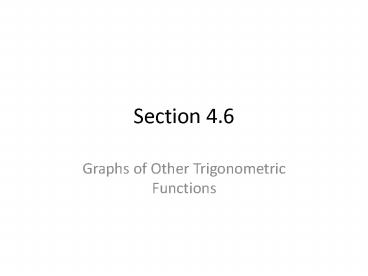Graphs of Other Trigonometric Functions - PowerPoint PPT Presentation
1 / 12
Title:
Graphs of Other Trigonometric Functions
Description:
Section 4.6 Graphs of Other Trigonometric Functions Overview In this section we examine the graphs of the other four trigonometric functions. After looking at the ... – PowerPoint PPT presentation
Number of Views:197
Avg rating:3.0/5.0
Title: Graphs of Other Trigonometric Functions
1
Section 4.6
- Graphs of Other Trigonometric Functions
2
Overview
- In this section we examine the graphs of the
other four trigonometric functions. - After looking at the basic, untransformed graphs
we will examine transformations of tangent,
cotangent, secant, and cosecant. - Again, extensive practice at drawing these graphs
using graph paper is strongly recommended.
3
Tangent and Cotangent
- Three key elements of tangent and cotangent
- For which angles are tangent and cotangent equal
to 0? These will be x-intercepts for your graph. - For which angles are tangent and cotangent
undefined? These will be locations for vertical
asymptotes. - For which angles are tangent and cotangent equal
to 1 or -1? These will help to determine the
behavior of the graph between the asymptotes.
4
y tan x
5
y cot x
6
Transformations
A amplitude p/B period (distance between
asymptotes). C/B gives phase shift from zero.
7
ExamplesGraph the Following
8
Secant and Cosecant
- The graphs of secant and cosecant are derived
from the graphs of cosine and sine, respectively - Where sine and cosine are 0, cosecant and secant
are undefined (location of vertical asymptotes). - Where sine and cosine are 1, cosecant and secant
are also 1. - Where sine and cosine are -1, cosecant and secant
are also -1.
9
y csc x(derived from graph of y sin x)
10
y sec x(derived from graph of y cos x)
11
Transformations
- To graph a transformation of cosecant or secant,
graph the transformation of sine or cosine,
respectively, then use the reciprocal strategy
previously discussed
A amplitude (affects the places where secant
or cosecant is equal to 1 or -1) 2p/B period
(distance between asymptotes) C/B phase
(horizontal) shift, left if (), right if (-)
12
ExamplesGraph the Following































